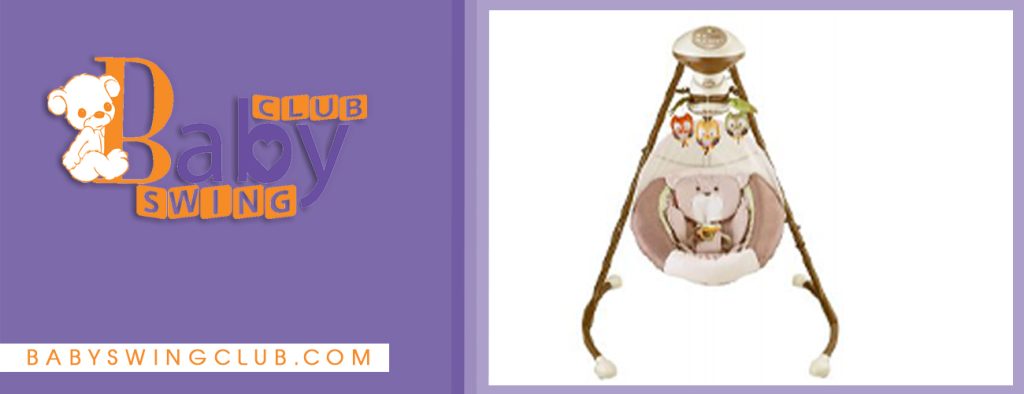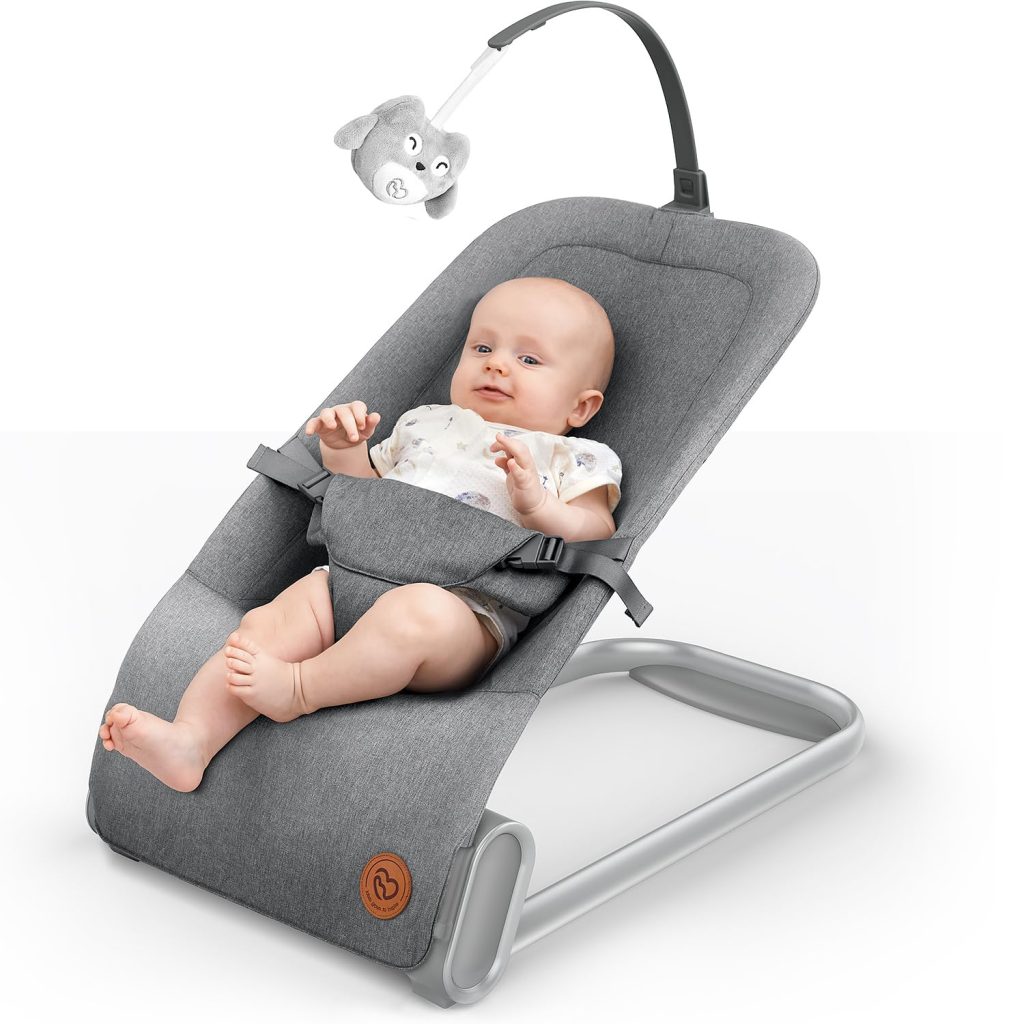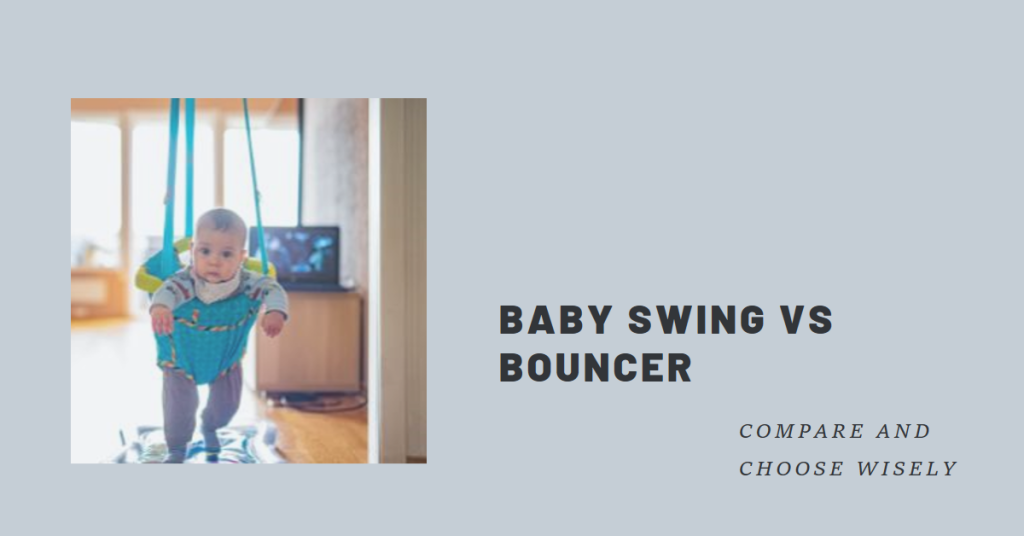American Baby Company Waterproof Fitted Crib and Toddler Mattress Protector, Quilted and Noiseless Crib & Toddler Mattress Pad Cover, White, 52"x28"x9"
17% OffIngenuity InLighten Baby Swing - Cool Mesh Fabric, Vibrations, Swivel Infant Seat, Nature Sounds, Light Up Motorized Mobile - Braden
$179.99 (as of April 28, 2024 00:31 GMT +00:00 - More infoProduct prices and availability are accurate as of the date/time indicated and are subject to change. Any price and availability information displayed on [relevant Amazon Site(s), as applicable] at the time of purchase will apply to the purchase of this product.)Parents know that motion and movement can be magical in calming and soothing fussy babies. Two popular products that use motion to entertain and relax infants are baby swings and bouncers. But what are the key differences, pros and cons between these motion devices?
This detailed guide explains everything parents need to know about baby swings versus bouncers. It covers how they work, safety factors, recommended features, and ideal usage scenarios to determine which is better suited for your family.
By understanding the unique benefits of both options, you can make an informed decision when registering for these nursery staples.
What is a Baby Swing?


A baby swing is a cradled seat that safely suspends babies and rocks them in a swinging, gliding motion. Many modern swings include:
- Multiple recline positions
- Vibration setting
- Mobile attachment
- Soothing sounds and music
- Removable infant insert
Swings provide a gentle front-to-back or side-to-side swinging movement powered by AC power or batteries. Parents can customize the motion, speed, and extra features to comfort and entertain baby.
What is a Baby Bouncer?


Baby bouncers are stationary frames that suspend babies above the floor on a lightly springed platform. Infants bounce themselves up and down through natural movements or by parents gently pushing the seat. Types of bouncers include:
- Stationary bouncers
- Vibrating bouncers
- Rocking bouncers
- Fully reclining bouncers
- Bluetooth-enabled “smart” bouncers
The lightly suspended seat allows for both bouncing and subtle vibrations to soothe babies. Some bouncers also include calming music, toys, and adjustable reclining seats.
Key Differences
Movement
- Baby swings provide a smooth swinging or gliding motion either side-to-side or front-to-back. The motorized movement aims to mimic motions babies find soothing.
- Bouncers utilize a spring or frame suspension that allows babies to use their movements to bounce themselves. It simulates the light jiggling from parents rocking or bouncing a baby in their arms. Some bouncers also rock or vibrate.
Power Source
- Most swings run on AC power when plugged in. Many also run on batteries allowing portability.
- Bouncers can be battery-powered, electric-powered, or manually operated with no power source.
Size
- Swings have a larger footprint, typically around 4 ft. long by 2 ft. wide. The swinging arc requires ample clearance space.
- Bouncers take up minimal floorspace, often 2 ft. long by 1.5 ft. deep. Their compact size fits in small homes.
Age Range
- Swings are ideal from newborn to about 6 months old. As babies get older and heavier, they often max out swing weight limits.
- Bouncers work from newborn through toddlerhood, up to around 24-30 months old in many cases.
Positions
- Most swings recline to multiple positions, from upright to fully reclined.
- Bouncers typically only recline a few levels or not at all. Some contemporary versions offer deeper recline options.
Portability
- Swings are bulkier and not intended to move from room to room. However, some fold for storage and travel.
- Bouncers are highly portable, lightweight, and easy to bring around the house or fold for travel.
Safety Considerations
The American Academy of Pediatrics advises that babies should not sleep or be left unattended in sitting devices like swings and bouncers. Always supervise babies in motion products.
Other Swing & Bouncer Safety Tips:
- Never use sitting devices as a replacement for a crib or bassinet for routine overnight sleep. Only let babies nap in swings/bouncers during daytime use.
- Ensure babies meet the weight minimums and don’t exceed maximums.
- Avoid any product modifications not approved by the manufacturer.
- Position away from hazards like windows, stairs, or cabinets baby could reach and impact.
- Avoid placing on uneven or unstable surfaces that could tip over.
- Check for recalled products. Register your model so the manufacturer contacts you directly if a recall is issued.
- Examine devices frequently for any signs of wear, damage, or loose parts. Discontinue use immediately if any issues are found.
Following safety precautions keeps your baby secure as they enjoy the soothing motions of swings and bouncers. Always defer to the manufacturer’s guidance.
Benefits of Baby Swings
Soothes with motion
The swinging and gliding motions comfort babies by recreating the sensations of being rocked in mom or dad’s arms. The gentle repetitive motion can relax babies and lull them to sleep.
Portable entertainment
Most swings run on batteries making them easily portable. This allows moving the swing from room-to-room so baby stays entertained and content.
Customizable options
Between adjustable swinging motions, variable speeds, music, and recline angles, swings allow customizing to baby’s preferences.
Hands-free convenience
The motorized swinging frees up parents’ hands. This allows completing chores and tasks while keeping baby close by and swinging.
Compact alternative to rockers
In small spaces where a full nursery rocking chair won’t fit, a swing provides rocking motions in a compact footprint.
Drawbacks of Baby Swings
- Larger footprint takes up significant space when not in use
- Bulkier and not as portable for travel
- Maximum weight limits mean a shorter useful lifespan
- Swinging motions can aggravate reflux in some babies
- Sound and mechanical noises may disturb light-sleeping babies
- Swinging in just one direction may limit head/neck positioning
Benefits of Baby Bouncers
Engages baby’s natural movements
Bouncing allows babies to interactively use their kicks and motions to bounce themselves. This gives them agency in play.
Highly portable
Light, compact bouncers are easy to bring anywhere in the house or pack for travel. This flexibility is useful for busy, on-the-go lifestyles.
Extended use lifespan
Bouncers accommodate babies up through toddlerhood, while swings max out at around 6 months old. More lifespan means more value.
Fosters developmental mobility
Bouncing engages developing leg muscles and helps strengthen baby’s coordination. Active bouncing fosters mobility.
Reduced risk of reflux
The vertical bouncing can minimize reflux issues sometimes triggered by the horizontal swinging motions of swings.
Drawbacks of Baby Bouncers
- Requires more effort interacting and bouncing baby yourself
- Less ability to soothe baby hands-free while completing tasks yourself
- May not be as effective at lulling fussy babies to sleep
- Stationary frame provides less motion variety than multi-directional swings
- Minimal or fixed recline options on some models
- Baby movements can cause tipping if bouncer isn’t set on a flat surface
Features to Look for in Swings & Bouncers
Swings
- Recline adjustability – Multiple recline angles allow adjusting upright to lie-flat as baby grows
- Swing direction options – Side-to-side and front-to-back swinging caters to baby’s preferences
- Variable speeds – Faster and slower swing speeds help find the most soothing tempo
- Foldability – Folding mechanisms enable compact storage and enhance portability
- Toys & music – Toys for visual engagement and music selections to enhance entertainment
- Travel compatibility – Lightweight designs and battery power ease transport for travel
- Easy cleaning – Removable, machine washable fabrics simplify cleaning up messes
Bouncers
- Vibration – Gentle vibrations help calm and soothe baby
- Toys & music – Similar to swings, toys and sounds enrich playtime
- Portability – Lightweight, compact construction makes bringing along on trips easy
- Deep recline – Models reclining to near-flat allow resting, playing, or bottle feeding
- Seat attachments – Some bouncers accommodate infant car seats to allow seamless transfer
- Easy cleaning – Being able to throw cushions into the washing machine is a lifesaver
- Non-slip feet – Rubberized feet prevent bouncing from sliding bouncers on flooring
Recommended Baby Swings by Age
Newborns 0-3 months
Graco Duet Soothe Swing + Rocker
- Dual swing and rocking motions
- Fully adjustable recline positions
- Runs on AC or batteries
- 25 lb weight capacity
Fisher-Price Sweet Snugapuppy Dreams Cradle ‘n Swing
- Both plug-in and battery-powered
- Music selection and rotating mobile
- Cozy infant insert and head support
- 16 speed settings to find baby’s favorite
3-6 months
Graco Glider LX Gliding Swing
- True gliding motion like a nursery glider
- Timer mode saves battery life
- Removable infant head support cushion
- 27 lb weight capacity
Graco DreamGlider Gliding Swing
- Glides side-to-side or front-to-back
- Adjustable recline and speed
- Vibration, music, sounds
- Room for growth with 30 lb capacity
Recommended Baby Bouncers by Age
Newborns 0-3 months
Baby Einstein Neptune’s Ocean Discovery Jumper
- Newborn seat with activity arch
- Calming vibrations and music
- Machine washable seat pad
- Light up toys for visual stimulation
Fisher-Price Infant-to-Toddler Rocker
- Reclines nearly flat for infants
- Vibrates to soothe fussiness
- Toys & activities for playtime
- High weight capacity up to 40 lbs
3-6 months
Jolly Jumper – Stand for Bouncers
- Suspends bouncer at ideal height
- Reduces strain on parents’ backs
- Folds flat for storage
- Use with your existing bouncer
Bright Starts Safari Smiles Bounce-a-Round Activity Center
- Interactive animal toys around seat
- Spring suspension for bouncing
- Supportive, upright seat position
- 30 lb weight capacity
Comparison Chart
Baby Swings | Baby Bouncers | |
|---|---|---|
| Movement | Gliding or swinging motions powered by motor | Bouncing on lightly springed suspension moved by baby |
| Power Source | Typically plug-in with option to run on batteries | Manual, battery-powered, or plug-in options |
| Size | Larger footprint around 4 ft. x 2 ft. | Compact, lightweight and portable |
| Age Range | Best approximately 0-6 months old | Use from newborn into toddlerhood up to 2 years old |
| Positions | Recline fully or partially upright | Typically more upright with minimal recline |
| Portability | Bulkier but some are foldable for transport | Extremely portable and easy to bring anywhere |
| Pros | Soothing swinging motions, entertainment features, hands-free convenience | Active play, engages baby’s movements, highly portable, longer lifespan |
| Cons | Large footprint, weight limits mean shorter lifespan, reflux triggers | Requires more effort bouncing baby yourself, less ability to soothe hands-free |
Frequently Asked Questions
Are baby bouncers or swings better?
There is no universally “better” option. Bouncers excel at portability and enabling interactive play. Baby swings sway to soothe fussy babies hands-free. Consider which features would benefit your family most. Many parents find value in owning both products.
Are baby swings safe for sleep?
No, swings and bouncers should not be used as routine sleep areas. Always supervise babies in motion products and relocate them to a crib for longer sleep. However, brief naps are permissible during daytime use. Follow all manufacturer guidelines.
How long can baby be in a swing?
Time limits depend on the model, but a general rule is active daytime use should not exceed 1-2 hour stretches. Never leave babies unattended. Swings help with fussiness but don’t replace cribs for overnight sleep. Babies still need flat surfaces for bone development.
When should you stop using a baby swing?
Once babies show signs they have outgrown the swing, like exceeding the weight limit or looking cramped, it’s time to stop swing use. This often occurs around 4-6 months old. Transition babies to floor play, bouncers, or baby-proofed spaces.
Do I need a bouncer if I have a swing?
A bouncer isn’t mandatory if you have a swing. However, they serve different purposes. Bouncers are extremely portable and interactive. Baby swings sway to soothe. Many parents find value in having both options to suit different needs.
Final Takeaways
While both swings and bouncers utilize motion to entertain and calm babies, they achieve it through different mechanisms. Lightly springed bouncer frames enable free movement powered by babies bouncing themselves. Motorized swings provide automated swinging and gliding motions operated by parents.
Considering your needs for portability, longevity, interactive play, and hands-free soothing will determine if a swing or bouncer is the better investment. Many families benefit from owning one of each to suit different scenarios. Use swings for calming fussy babies hands-free and bouncers for engaged floor time play.
Whichever you choose, follow all safety guidelines and don’t overuse motion products. When used responsibly alongside other activities, both swings and bouncers can help enrich your baby’s days.


Hi there!
My name is Sabrina. As a devoted mother of four children, I have personally experienced the benefits and effectiveness of various types of baby swings. As the founder of babyswingclub.com, I have dedicated myself to providing valuable information and insights into the world of baby swings.
My thorough research and hands-on experience allow me to offer valuable insights into the features, safety standards, and overall performance of different baby swings.

























